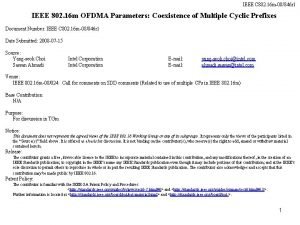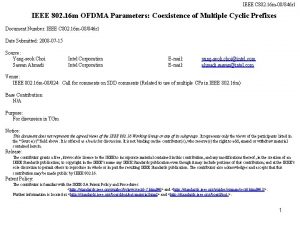IEEE C 802 16 m08846 IEEE 802 16





- Slides: 5

IEEE C 802. 16 m-08/846 IEEE 802. 16 m OFDMA Parameters: Coexistence of Multiple Cyclic Prefixes Document Number: IEEE C 802. 16 m-08/846 Date Submitted: 2008 -07 -14 Source: Yang-seok Choi Sassan Ahmadi Intel Corporation E-mail: yang-seok. choi@intel. com ahmadi. sassan@intel. com Venue: IEEE 802. 16 m-08/024: Call for comments on SDD comments (Related to use of multiple CPs in IEEE 802. 16 m) Base Contribution: N/A Purpose: For discussion in TGm Notice: This document does not represent the agreed views of the IEEE 802. 16 Working Group or any of its subgroups. It represents only the views of the participants listed in the “Source(s)” field above. It is offered as a basis for discussion. It is not binding on the contributor(s), who reserve(s) the right to add, amend or withdraw material contained herein. Release: The contributor grants a free, irrevocable license to the IEEE to incorporate material contained in this contribution, and any modifications thereof, in the creation of an IEEE Standards publication; to copyright in the IEEE’s name any IEEE Standards publication even though it may include portions of this contribution; and at the IEEE’s sole discretion to permit others to reproduce in whole or in part the resulting IEEE Standards publication. The contributor also acknowledges and accepts that this contribution may be made public by IEEE 802. 16. Patent Policy: The contributor is familiar with the IEEE-SA Patent Policy and Procedures: <http: //standards. ieee. org/guides/bylaws/sect 6 -7. html#6> and <http: //standards. ieee. org/guides/opman/sect 6. html#6. 3>. Further information is located at <http: //standards. ieee. org/board/pat-material. html> and <http: //standards. ieee. org/board/pat >. 1

Coexistence of Multiple CP on the Same RF Carrier • Macro BS uses Normal CP – Femto-cell uses short CP • Unavoidable timing offset – Two signals arrive at Rx – FFT timing will be based on either one – Even with frequency reuse, ICI is unavoidable after FFT Macro BS Femto Subch 2 Timing Offset Subch 1 Normal CP (Macro BS) Short CP (Femto-cell) S 0 S 1 S 2 S 3 S 4 S 5 S 6 2

ICI Power • SIR=0 d. B – Two signals arrive with same average power but orthogonal in frequency – Due to the unavoidable timing offset, the ICI is observed after FFT – Excess delay spread=T/16 3

ICI Power (cont’d) • RS/Femto/Pico cell may be located close to macro BS – DL • high operating SNR • ICI is not negligible – UL • UL signal from Macro cell edge is weak • Interfering UL signal attached to pico/Femto/RS can be significant • ICI is not negligible, reducing Macro cell coverage • Fluctuation of the ICI – Depending on the loading change of interfering BS, the ICI power is fluctuating even with frequency reuse – CQI is dynamically changing (affecting LA, AMS due to CQI feedback delay) • Multiple CP coexistence in Preamble (SCH) as well? – If so, serious impacts on preamble detection/synchronization at boundary between Femto-cell and Macro BS 4

Conclusions • • Operation of the system with multiple cyclic prefixes at the time for different environments may result additional interference when using a single RF carrier. The loss in coverage area or SINR can’t be offset by the incremental gain It has not been shown whether multi-CP operation is required to fulfill IMTAdvanced requirements. Different deployment scenarios or deployment in different frequency bands can use different CP lengths (preferably with some implementation-friendly relationship) suitable for propagation characteristics of those media. A shorter CP can be used for Femto-cells and a longer CP can be used for macro-cell. However, no coexistence in the same RF carrier A smaller sub-carrier spacing is desirable in lower frequency bands and a larger sub-carrier spacing is desirable for higher frequency bands relative to the default sub-carrier spacing Nevertheless, the same set of OFDMA parameters should be used throughout the network for each RF carrier. 5








